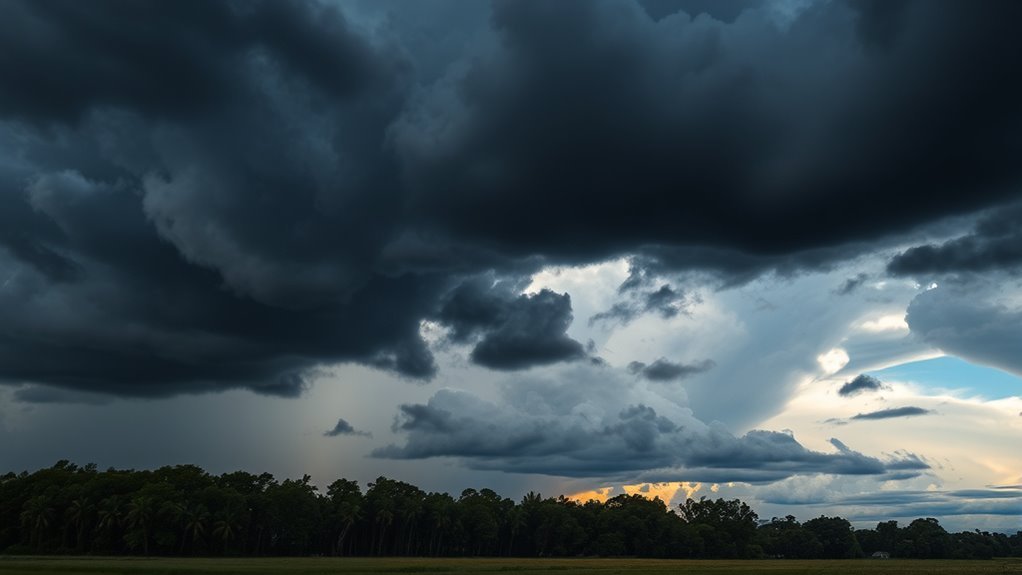Squalls play a vital role in the development and intensity of thunderstorms. They generate strong updrafts by creating rapid rises of warm, moist air, which increases atmospheric instability. The abrupt changes in moisture and wind conditions further improve storm rotation and precipitation rates. Squalls can lead to brief but intense bursts of wind and heavy rainfall, contributing to severe weather events. This dynamic interaction shapes the nature and severity of thunderstorms, revealing additional information into storm behavior.
Main Points
- Squalls create sudden increases in wind speed, enhancing the rotation and intensity of thunderstorms.
- Rapid uplift of warm, moist air during squalls increases atmospheric instability, promoting stronger storm development.
- Squall lines transport moisture from the surface, contributing to humidity and precipitation levels in thunderstorms.
- The temperature shifts caused by squalls destabilize the atmosphere, fostering powerful updrafts essential for thunderstorm formation.
- Increased atmospheric turbulence associated with squalls leads to more severe weather conditions and intense thunderstorms.
Understanding Squalls: Definition and Characteristics
Squalls are sudden, intense bursts of wind that are often accompanied by precipitation, typically seen in the context of thunderstorms or rapidly changing weather conditions. These wind events can occur unexpectedly, leading to sharp fluctuations in temperature and pressure. Characteristically, squalls are marked by their brief duration, often lasting only minutes, yet they can reach speeds of over 30 knots.
The onset of a squall is often heralded by darkening skies and an increase in atmospheric turbulence. During this phenomenon, gusts can shift direction rapidly, creating hazardous conditions for both land and maritime activities.
In addition, squalls frequently emerge from the leading edge of a thunderstorm, acting as a precursor to more severe weather events. Understanding these characteristics is essential for meteorologists, as they play a notable role in the dynamics of storm development and intensity, setting the stage for additional atmospheric interactions.
The Role of Moisture in Thunderstorm Formation

Moisture serves as a fundamental ingredient in the formation of thunderstorms, acting as the fuel that drives the storm's development. When warm, moist air rises, it cools and condenses, forming clouds and releasing latent heat. This process not only creates clouds but also boosts the energy available for the storm.
High humidity levels in the atmosphere are imperative, as they contribute to the production of precipitation and the general intensity of thunderstorms. Regions with abundant moisture often experience more frequent and severe thunderstorms, as the saturated air masses provide the necessary conditions for storm initiation.
Additionally, the interaction between moist air and cooler air can lead to the development of strong updrafts, which further supports thunderstorm growth. Consequently, moisture is an essential factor that influences both the formation and intensity of thunderstorms, highlighting its significance in meteorological phenomena.
Instability and Updrafts: Key Components of Thunderstorms
Instability in the atmosphere plays a critical role in the development of thunderstorms, serving as a catalyst for powerful updrafts. When warm, moist air near the surface rises, it encounters cooler air aloft, creating a buoyant environment. This temperature difference is significant; the warmer air is less dense and continues to ascend, forming updrafts that can reach considerable heights.
As these updrafts rise, they cool and condense, releasing latent heat, which further improves their strength.
The presence of instability is often measured by indices such as the Lifted Index or the Showalter Index. Higher values indicate a greater potential for thunderstorm development.
Additionally, the vertical wind shear can influence the organization and intensity of these updrafts. Together, instability and robust updrafts are fundamental components that drive the formation and intensification of thunderstorms, leading to severe weather phenomena.
How Squall Lines Enhance Atmospheric Conditions

Dynamic interactions within the atmosphere are considerably influenced by the presence of squall lines, which serve as organized bands of thunderstorms. These formations play a vital role in enhancing atmospheric conditions, contributing to the development of severe weather systems.
The effects of squall lines can be summarized as follows:
- Increased Lift: Squall lines generate strong updrafts, promoting vertical movement in the atmosphere and enhancing thunderstorm formation.
- Enhanced Moisture Transport: The movement of squall lines helps to transport moisture from the surface, contributing to the humidity necessary for storm development.
- Temperature Changes: The passage of squall lines often leads to notable temperature shifts, which can destabilize the atmosphere and encourage further thunderstorm activity.
- Wind Shear: Squall lines introduce changes in wind speed and direction, which can amplify the intensity and longevity of thunderstorms.
These factors collectively boost the potential for robust atmospheric phenomena.
The Relationship Between Squalls and Severe Weather Events
Squalls are often associated with increased storm intensity, creating conditions that can lead to severe weather events.
Their dynamic nature can markedly improve lightning activity, contributing to the comprehensive severity of thunderstorms.
Understanding this relationship is essential for predicting and mitigating the impacts of severe weather.
Squalls and Storm Intensity
Severe weather events often manifest through squalls, which are defined by sudden increases in wind speed and intense precipitation. These atmospheric disturbances play a vital role in storm intensity, often leading to the development of severe thunderstorms.
The relationship between squalls and storm intensity can be emphasized by several key factors:
- Increased Wind Shear: Squalls create notable wind shear, which improves thunderstorm rotation.
- Improved Instability: The rapid uplift of warm air contributes to greater atmospheric instability.
- Heavy Rainfall: Intense precipitation can lead to flash flooding, compounding storm severity.
- Rapid Changes in Temperature: Squalls can cause abrupt temperature drops, further energizing storm systems.
Understanding these elements highlights the essential role squalls play in severe weather dynamics and storm intensity.
Impact on Lightning Activity
While squalls contribute greatly to storm intensity, they also play an essential role in improving lightning activity during severe weather events.
The rapid ascent of air associated with squalls leads to increased atmospheric instability, which is a primary driver of thunderstorms. This instability promotes the development of strong updrafts, creating conditions conducive to the buildup of electrical charges within storm clouds.
As the squall line moves, it can generate considerable electrical discharge, resulting in frequent and intense lightning strikes. Additionally, the collision of ice particles within the storm boosts the likelihood of lightning, as these interactions aid the separation of positive and negative charges.
Consequently, squalls not only intensify storms but also markedly increase the frequency and intensity of lightning activity.
Case Studies: Notable Thunderstorms Fueled by Squalls
As atmospheric conditions align, the interaction between squalls and thunderstorms can lead to exceptional weather phenomena. Several notable cases illustrate the powerful role squalls play in amplifying thunderstorms, showcasing their potential impact.
- The 2011 Joplin Tornado: A squall line preceding the tornado contributed to an environment ripe for severe thunderstorms, resulting in one of the deadliest tornadoes in U.S. history.
- Hurricane Harvey (2017): Squalls associated with the outer bands of Harvey prompted intense rainfall and flash flooding in Texas, highlighting the danger of squall-driven storms.
- The 2020 Midwest Derecho: This extreme wind event was fueled by squalls, leading to widespread damage across multiple states and exemplifying how squalls can amplify thunderstorm systems.
- Tropical Storm Andrea (2013): Squalls ahead of this storm intensified thunderstorms, bringing heavy rain and strong winds to the southeastern U.S., demonstrating the complex interplay of squalls and tropical systems.
Safety Precautions During Squall and Thunderstorm Events
During squall and thunderstorm events, it is essential to implement safety precautions to protect individuals and property.
Monitoring weather alerts guarantees timely awareness of potential threats, while securing outdoor objects can prevent injuries and damage.
Additionally, having a plan for emergency evacuations can greatly improve safety in the face of severe weather conditions.
Monitor Weather Alerts
Monitoring weather alerts is essential for safety when squalls and thunderstorms threaten. Staying informed enables individuals to take appropriate precautions and minimize risks associated with severe weather.
Here are four key steps to follow:
- Sign Up for Alerts: Register for local weather notifications via mobile apps, text messages, or email to receive real-time updates.
- Stay Informed: Regularly check reliable weather websites or broadcasts for the latest forecasts and warnings.
- Understand Alerts: Familiarize oneself with the meanings of different weather alerts, such as watches and warnings, to gauge the severity of the situation.
- Create a Safety Plan: Develop a family emergency plan that includes communication strategies and safe locations during thunderstorms and squalls.
Secure Outdoor Objects
Securing outdoor objects is essential before a squall or thunderstorm strikes, as strong winds and heavy rain can turn loose items into dangerous projectiles. Homeowners should identify and secure any loose furniture, garden tools, and decorations that could be tossed about by gusty winds.
This includes bringing in patio umbrellas, securing trash cans, and guaranteeing that any lightweight items are stored indoors. Additionally, any larger items that cannot be moved should be anchored or weighted down to minimize risk.
It is also wise to check that windows and doors are closed tightly to prevent water ingress and damage. Taking these precautions not only protects the property but also helps guarantee the safety of those in the vicinity during severe weather events.
Plan Emergency Evacuations
Effective planning for emergency evacuations is crucial when severe squalls and thunderstorms threaten a community. Timely and organized evacuations can markedly reduce risks to life and property.
Communities should implement the following strategies to guarantee readiness:
- Designate Safe Zones: Identify and communicate locations that provide shelter from severe weather.
- Establish Communication Channels: Use multiple platforms, such as social media and local news, to disseminate timely evacuation alerts.
- Conduct Drills: Regularly practice evacuation procedures with community members to assure familiarity and efficiency during actual events.
- Prepare Emergency Kits: Encourage residents to have emergency kits ready, containing essentials such as food, water, medications, and important documents.
A proactive approach to planning can improve community resilience against squalls and thunderstorms.
Common Questions
How Can Squalls Impact Local Weather Patterns Long-Term?
Squalls can considerably alter local weather patterns over time by influencing temperature, humidity, and wind dynamics. Their frequent occurrence may lead to persistent changes in precipitation patterns, potentially affecting ecosystems and agricultural practices in the affected regions.
Are Squalls More Common in Certain Seasons?
Squalls are indeed more common in specific seasons, particularly during spring and summer months. This seasonal prevalence is influenced by atmospheric conditions that favor the development of these intense, short-lived weather events.
What Tools Are Used to Predict Squalls?
Meteorologists utilize various tools to predict squalls, including Doppler radar, satellite imagery, and weather models. These instruments help analyze atmospheric conditions, track storm movements, and anticipate the potential for squall line formation and intensity.
How Do Squalls Interact With Other Weather Systems?
Squalls interact with other weather systems by enhancing instability, redistributing moisture, and generating wind shear. These dynamics can lead to intensified precipitation and lightning activity, influencing general storm behavior and potentially altering weather patterns in surrounding areas.
Can Squalls Occur Without Thunderstorms?
Squalls can indeed occur without thunderstorms. They often manifest as strong, gusty winds associated with rapidly changing weather conditions, which may not always include the precipitation or electrical activity characteristic of thunderstorms.

